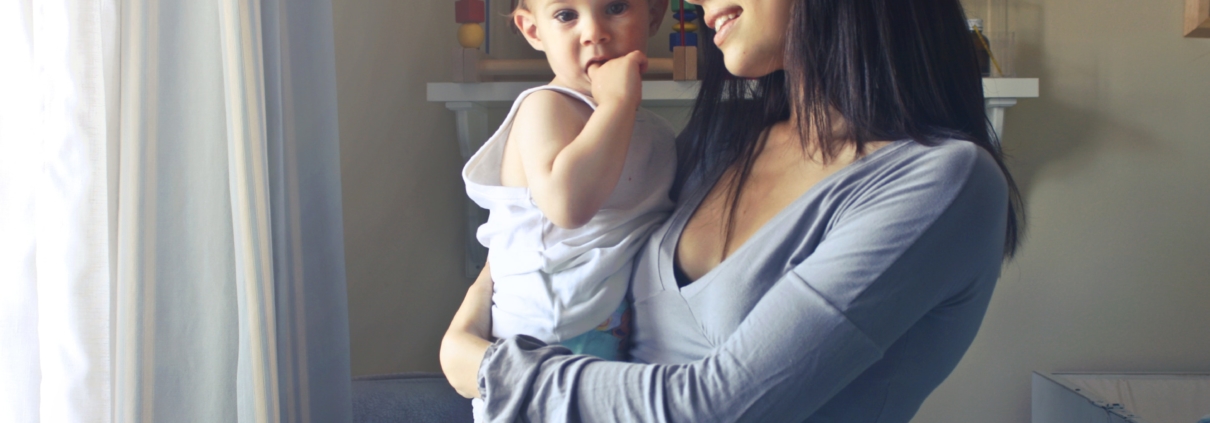Top 10 Breastfeeding Problems and Solutions
By: Melissa Portunato, IBCLC
You had envisioned yourself latching your beautiful new baby to your breast and it would instantly be magical. Pure bliss! Or so you thought. But, breastfeeding didn’t come as naturally as you thought it would and it feels far from magical. Instead, you feel frustrated, disappointed, and like giving up.r. The truth is, for most of us, breastfeeding is not what we thought it would be like at all. Just like with anything worthwhile in life, breastfeeding takes hard work and commitment. But once you can get past those pesky common challenges of the first few weeks, you can really start to enjoy your breastfeeding journey and begin to truly bond with your baby.
We came up with the 10 most common breastfeeding problems and answers to get you through those tough times.
#1 Painful latch
Every time you know feeding time is coming around, your toes curl and you start to get major anxiety because it hurts to breastfeed! Most likely, it’s because your nipple is rubbing on the roof of your baby’s mouth causing discomfort. So how can you work on perfecting the latch to get rid of this dreadful feeling? Start the feeding with your nipple on baby’s nose, wait for baby to open wide, and then bring baby quickly (chin first) towards you. This can help aim your nipple deeper into baby’s mouth. When done correctly, you should instantly feel a difference. Phew!
#2 Sleepy baby at breast
You changed baby’s diaper, tickled their toes, got them all undressed and still can’t seem to wake baby from dreamland. A newborn baby should be nursing a minimum of 8 to 12 times per day. If baby is still not at their birth weight, they most definitely need to be woken up to feed throughout the night. For the first 6 weeks, try not to swaddle baby or offer a pacifier. This can interfere with nursing cues and cause baby to feel full and cozy and not want to nurse. Hand express for a few minutes before offering the breast. Sometimes, just a few drops of breastmilk on a sleepy baby’s lips will get them to want to nurse. Use breast compressions while you nurse too! This can help keep baby awake with a steady flow of milk.
You can also try turning down the lights and keeping baby skin to skin. So, even down to a diaper with a light blanket on top of baby can help. This helps stimulate your milk makes hormones and the smell of your skin/breast can often help with feedings.
If your chubster is already back up at their birth weight, talk to your pediatrician. It’s most likely OK to hit the snooze button on that alarm. Finally rest!
#3 This kid won’t stop nursing!
You feel your baby is practically attached to you morning, noon, and night. You can’t catch a break and you’re tapped out! Cluster feeding is when baby bunches nursing sessions close together about every 45-60 minutes. This feeding pattern is normal for young babies and coincides with growth development, but cluster feeding is exhausting! But we promise, there is hope! These marathon feedings will increase your milk supply and are typically followed by long sleeping stretches for baby. Sit back, relax, and scroll through your favorite newsfeed, sleep is on the horizon.
#4 Baby refusing the breast
If your baby was nursing and suddenly is refusing the breast, you could be experiencing a nursing strike. Nursing strikes will typically last from just a few short days to over a week. They can be caused by a variety of different factors like an illness, teething, major changes in routine, or long periods of separation from your baby.
Take it back to the basics! Dim the lights and do skin to skin with baby on your bare chest with only a diaper. Offer the breast frequently but, don’t ever force baby! It should be a gentle “wooing” back. You can even have baby gently wake up next to your bare breast. Often, babies will be more willing to nurse when just waking up versus really hungry.
Limit bottles as much as possible and offer the breast first. but, don’t wait until baby is too hungry. Try to have someone else give the bottle besides mommy.
#5 Sore nipples
Your nipple is elastic and as it begins to stretch you can experience soreness. Soreness in the first few weeks is normal but should subside after about two weeks. Continued soreness, pain, cracking, and bleeding is not normal. It’s best to work closely with an International Board Certified Lactation Consultant to ensure baby is latched on properly. The best way to treat sore nipples is with your very own breast milk! Yep, pretty incredible, huh? Studies show the antibacterial properties in breastmilk makes it the perfect substance to heal nipples and keep them healthy. Hand express breast milk on your nipples after every feeding and allow to air dry. Your nipples will be feeling better in no time!
Make sure you are changing your breast pads frequently, this will help prevent any infection and allow your nipples to heal faster.
#6 Engorgement
It’s been a few days and your milk has officially made its grand entrance. HELLO! Engorgement can make it difficult for baby to latch. To help, you can apply a warm cloth and softly massage your breasts a few minutes prior to nursing. It’s very important during this time to nurse frequently! Offer the breast often and ensure you do some helpful breast massage while nursing. If after nursing or pumping you still feel engorged, fill up a large basin with warm water and lean over it to let gravity naturally drain any excess milk from your breasts. Do this while softly massaging and hand expressing. After you’re done, you can ice or use a cold compress for 10 min to help bring down any swelling.
If you have redness on your breasts, they feel hot to the touch, you have a fever, or chills call your health practitioner, it could be a sign of an infection.
#7 Clogged ducts
Outch! Clogged ducts can be extremely painful but completely treatable. How did you even get them in the first place? A clogged duct can be caused by a variety of different reasons from prolonged time without milk removal, shallow latch, restrictive clothing or even stress. The fastest way to treat clogged ducts is by frequently nursing or pumping. Try nursing in the “dangling feed” position. Practice massaging your breasts while nursing or pumping, no matter what position you use each time. You want to start massaging above where you feel the clog and gently towards the nipple. You can use a warm compress before you nurse or pump to help with milk removal.
Alternate heat and cold on the area affected. If you find you have a milk blister, avoid trying to squeeze because it can make things worse. The milk blister or bleb will naturally draw out as the clog subsides.
The most important thing to remember with clogged ducts is that they are progressively getting better, not worse. Most clogged ducts subside within 48 hours. If pain continues, or other symptoms appear, give your doctor a call.
#8 Tongue Ties
You’ve spent countless hours looking under your baby’s tongue and upper lip comparing it to pictures you found on the internet to assess the issues. A tongue tie is when the connective tissue under your baby’s tongue is too tight, too thick, or both. A tongue tie is commonly accompanied by a lip tie – the upper lip tissue that connects to the gum can be tight or too thick too. Both tongue and lip ties can restrict mobility in oral function causing issues with breastfeeding.
Unfortunately, ties often go undiagnosed. If you hear loud clicking when baby is nursing, baby is not gaining weight, has reflux or you continue to experience nipple soreness it’s important to have baby evaluated by a specialist such as an International Board Certified Lactation Consultant or a Pediatric Dentist.
In the meantime, pump if it is too painful to put baby to the breast. And be sure to be treating your nipples! See tip #5
#9 Thrush
Stabbing nipple pain, itchiness, and shiny or flaky skin on the nipple or areola can all be signs of thrush. Thrush is a common fungal infection caused by the overgrowth of yeast or “candida.” Candida can be found in its natural environment pretty much all over the human body but when it starts to multiply it can cause an infection. Thrush can be a side effect of antibiotics too! Talk to your doctor if you are experiencing any of the above symptoms and suspect you have thrush. Both you and baby will need to be treated. Ask about starting probiotics for you and baby! This can help replenish the healthy bacteria in the gut for a quicker recovery and most importantly prevent thrush from recurring.
#10 Mastitis
Last but not least, you think you might have the most dreaded condition in the whole breastfeeding universe; Mastitis. Mastitis is an inflammation of the breast tissue. Symptoms of mastitis include redness of the breast, hard and hot on the affected area, and feeling like you’re catching a nasty flu bug. If symptoms persist or get worse after a few days, it’s likely your doctor will prescribe antibiotics to treat an infection.
There are many causes of mastitis including lack of breastmilk removal, worsening clogged ducts, change in breastfeeding patterns, and even a tight bra! It’s important to continue to breastfeed during this time and keep your milk flowing. Make sure you REST and get plenty of fluids as this often can occur due to a suppressed immune system. You need to take care of yourself so you are able to take care of your little one!
Tips for relief are the same as when treating a clogged duct. See tip #7.
If you are experiencing any one of these common breastfeeding issues and still can’t seem to find relief, trust your mommy instincts and seek professional help from an International Board Certified Lactation Consultant. Never quit on your worst day! Always remember why you wanted to breastfeed in the first place. You’re not alone in your struggles and you’re doing the very best you can. Surrounding yourself with breastfeeding support will make a world of a difference. Join our online community on Facebook and connect yourself with other moms who will meet you exactly where you are on your breastfeeding journey.




Leave a Reply
Want to join the discussion?Feel free to contribute!